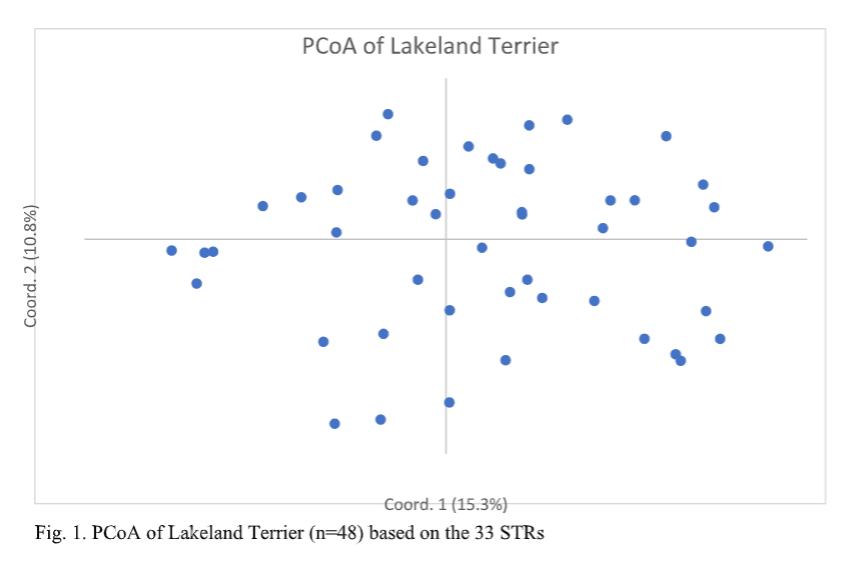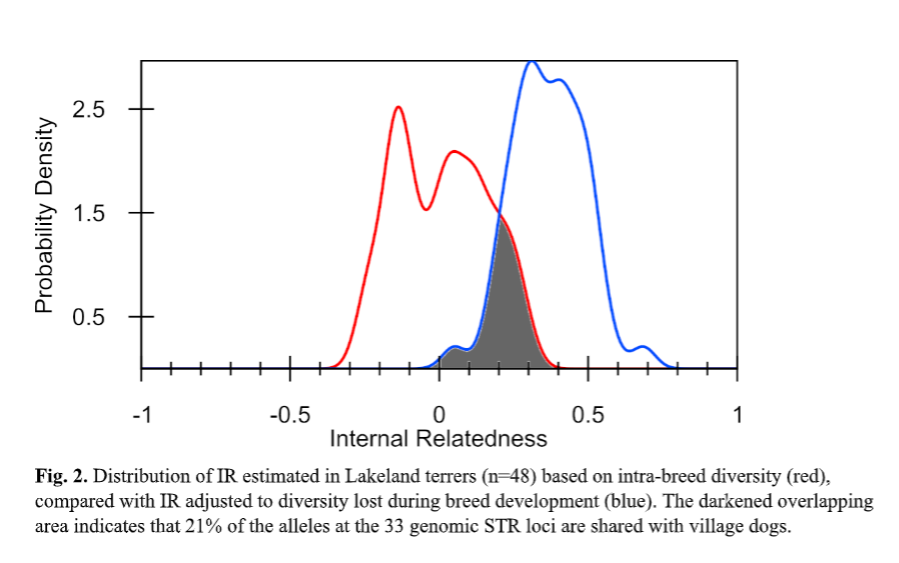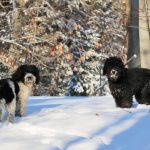
Initial Breed Summary: Lakeland Terriers
The Lakeland Terrier is a rare breed of terrier with very low numbers worldwide. According to UC Davis’ summary, “The Lakeland terrier breed is listed along with 114 of 173 UK breeds as at ‘critical risk for extinction’ based on the small number of registered breeding dogs (n ≤ 115)”. What has UC Davis and esteemed Dr. Niels Pedersen DVM PhD found in regards to the breed? You can find the full report here.
Inbreeding – how genetically similar are the parents of typical Lakeland Terrier?
 Dr. Pedersen found the following in terms of the inbreeding values of this population:
Dr. Pedersen found the following in terms of the inbreeding values of this population:
…even though the standard genetic assessment indicated that this group of dogs was
from a randomly breeding population, one quarter of the individuals were more outbred than
indicated and one-fourth more inbred. It is noteworthy the one-fourth inbred dogs had IR scores
comparable to offspring of first-cousin (~ 0.125) or full-sibling (0.250) parents from a random
breeding population. The few dogs with scores >0.250 were genetically equivalent to offspring
of full-sibling parents that were also a product of inbred parents.
Interpretation? Lakeland Terriers have for the most part been selecting for unrelated breeding partners, however about one fourth of the breeding population is quite inbred due to the small gene pool and could benefit from making sure that their outcrosses are really outcrosses and their linebreedings are not too close.
Breedwide diversity
Biodiversity and allelic richness are terms we try to discuss regularly at BetterBred. Namely, how many different versions of genes or alleles exist in each breed? Breeds with more allelic richness and whose genetics are also well distributed throughout the population tend to be healthier. So what did they find about the Lakeland Terrier population?
One of the first things you can notice is that Lakeland Terriers form a single breed with no clustering within the breed, or apparent bottleneck, as seen in the PCoA graph above (figure 1 above).
But what about biodiversity or allelic richness? Lakeland Terriers have low biodiversity in comparison to other tested breeds, the lowest of the breeds tested to date. Breeds with similar low biodiversity include Alaskan Klee Kai, Swedish Vallhund and Shiloh Shepherds. However, as more of this breed population are tested, likely more biodiversity will be found.
Average alleles per locus and effective alleles per locus are aspects that we discuss in these breed reports. The closer the effective alleles (we call these “alleles that are effectively contributing to your population”) are to the average alleles per locus, the better distributed the genetics in the breed are. Why would you want well distributed genetics? It keeps risk of unwanted recessive traits from appearing, lowers risk of random loss of diversity (called genetic drift) and it lowers the frequency of both simple and complex disease haplotypes that might unintentionally become more common if there were a bottleneck. The average alleles per locus in this breed was found to be 4.24, while the effective alleles per locus was found to be 2.46.
What does this mean? The effective alleles are closer to the average alleles per locus than is typical for most breeds, meaning – in this tested sample – the Lakeland Terrier breed community is doing a good job maintaining what they have.
Each breed community should make an effort to raise their effective alleles per locus. How do you do this? You use BetterBred’s breed management software to breed for higher than breed average Outlier Index (OI). This measurement was created to help maintain healthy distribution of breed genetics or redistribute unbalanced diversity, even while breeders select for the traits they want in their dogs.
 Diversity compared to village dogs
Diversity compared to village dogs
Dr. Pedersen’s hallmark comparison is to a combined population of village dogs. These domestic dogs have not been shaped by human effort, but instead have evolved through random breeding and natural selection. They therefore have a great amount of genetic diversity which is representative of the original diversity dogs had prior to modern breeding methods which changed them. Dr Pedersen therefore assesses the IR results based on only their own genetic data and compares them to their results using the village dog genetics – called IRVD. The difference between these two results illustrates the diversity that has been lost in each modern breed.
From the report:
This group of Lakeland terriers possess 21% of the genetic diversity that currently exists in village dogs. If 21% of available genetic diversity has been retained, 79% has been lost in breed creation. The retention of 21% of known genetic diversity is both lower and higher than other breeds. For instance, the Swedish Vallhund has retained only 7% of canine genetic diversity, the Doberman Pinscher 15% and the Shiloh Shepherd 27%, while at the highest level the Miniature Poodle has retained 51%, the Golden Retriever 50.4% in Labrador retriever 54%, and Toy Poodle 60%.
Translation? Lakeland Terriers have lost a significant amount of biodiversity in comparison to the other tested breeds to date. However, this may change as more of the breed is sampled worldwide.
DLA – Dog Leukocyte Antigen
A Look at the Dog’s Immune System!
Considering that only 48 Lakeland Terriers have been tested to date, very little diversity in the DLA has been found.
According to the report:
There is one unique feature in the DLA class I and II haplotypes – the same DLA class I (1012) and class II (2003) haplotypes were found in 45/48 of the dogs tested. Twenty-four of these 45 dogs were heterozygous for 1012/2003 and 19/45 were homozygous. If this dominance of the 1012/2003 haplotypes remains after testing more dogs, which is likely, it means that almost all contemporary North American Lakeland terriers descended from a single founder or founder line. It remains to be determined whether this loss of DLA diversity occurred at the level of the original founders in England or from artificial genetic bottlenecks that occurred after the registry was closed.
The DLA haplotypes 1012/2003 represented 71% of the tested alleles, which demonstrates a significant bottleneck in the DLA of the Lakeland Terrier. Breeders should take note of the atypical DLA haplotypes in the population so as not to lose them to genetic drift. You can read more about using DLA in a breeding program here.
The breed report also noted the following:
The dominant 1012 DLA class I haplotype is found in many breeds, but the highest incidence of sharing is with the English bulldog and the Biewer/Yorkshire terriers. The dominant 2003 DLA class II haplotype is at highest incidence in the Flat Coated retrievers, Havanese, Miniature and Toy poodles and Biewer/Yorkshire terriers. The combined 1012/2003 haplotype was strongly shared with the English bulldog and the Biewer/Yorkshire terriers. It is not surprising to see the relationships between Lakeland terriers and many other dog breeds of mainly European origin. The relationship with the Biewer/Yorkshire terriers was expected. However, the English bulldog relationship was less obvious and may be explained by early descriptions of the Bulldog as a small aggressive bull-baiting type dog. This activity is like the tenacious English-bred terriers called upon to attack vermin in their lairs.
DLA comparisons are always extremely interesting as it can inform on origins of breeds; breeds that have more DLA association indicate evolutionary development of breeds, as opposed to those with less DLA haplotypes in common.
Conclusion
From Dr. Pedersen’s report:
This initial study of 48 Lakeland terriers suggests that the breed is extremely lacking in genetic diversity. Although it is possible that additional diversity will be discovered as more dogs from diverse regions are tested, any additional autosomal STR alleles or DLA class I and II haplotypes will be at a comparatively low incidence. Also, this group of 48 dogs is entirely from North America and may not reflect dogs from other parts of the world. These are reasons to test more dogs as well as individuals from other parts of the world, but from historical regions such as the UK or from areas where they became established at an earlier time than North American dogs.
More biodiversity may be discovered as more dogs are tested. Samples are needed from European countries.
Our Recommendation
The Lakeland Terriers that have thus far been sampled show that there is very little biodiversity within the breed and it will be vital for them to attempt to retain this diversity as the breed is at risk for extinction. More samples are needed to see if more biodiversity can be found, especially if this first initial sample was from a few select bloodlines.
We recommend that breeders continue to breed to maintain the relatively well distributed diversity of the breed, so as not to lose more allelic richness to genetic drift. Breed for IR at or below zero and OI at or above breed average. When all else is equal, take note of atypical DLA haplotypes and make an effort to redistribute those that are poorly represented. If you have a Lakeland Terrier and would like to contribute to the research phase, you can do so here.

 Previous Post
Previous Post Next Post
Next Post


